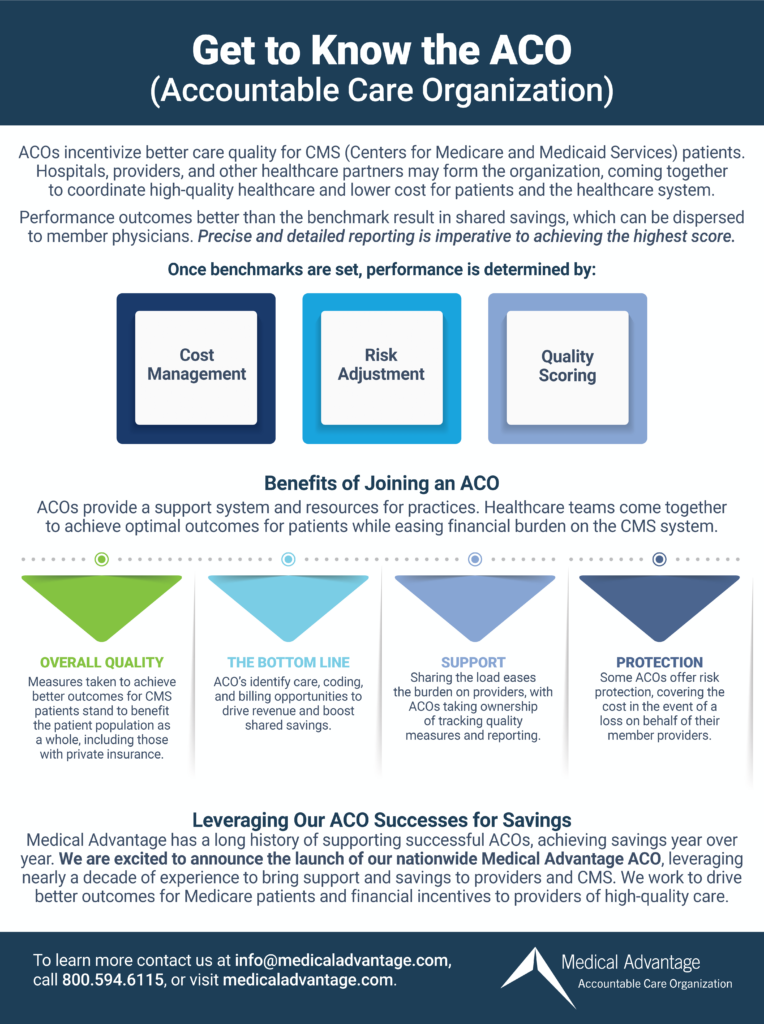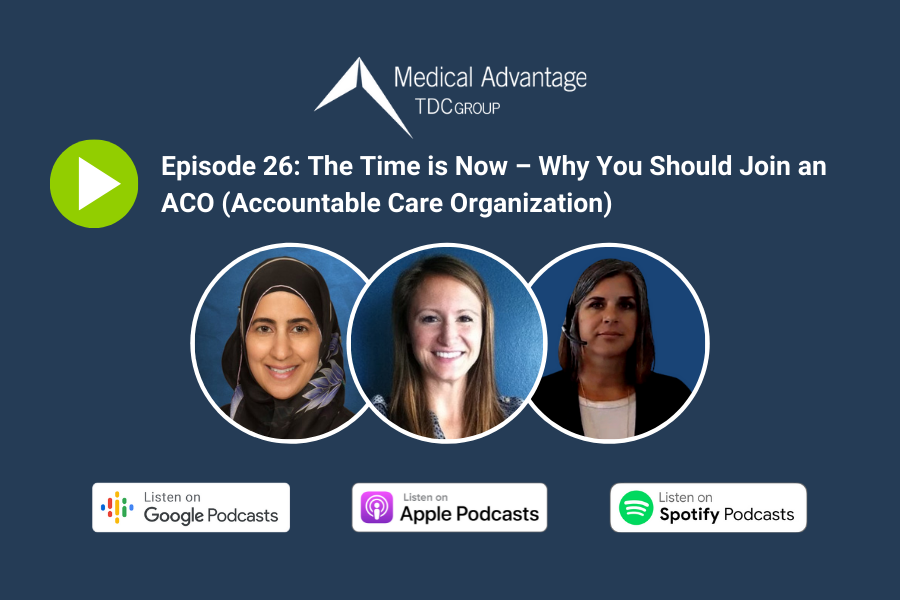When it comes to acronyms, the world of healthcare is in abundance. So, how does an ACO work, and what is it?
An ACO, or Accountable Care Organization, is joined voluntarily by physicians, hospitals, and other medical providers to incentivize the delivery of high-quality healthcare. While it has been compared to an HMO (Health Maintenance Organization), ACOs involve Medicare and Medicaid patients exclusively.
In 2022, there are now 483 ACOs providing care for 11 million Medicare patients. Medical Advantage is directly involved with an ACO that has been running successfully since 2014 – made up of around 40 providers and generating more than $80 million in savings.
How An ACO (Accountable Care Organization) Works
ACOs are a product of the ACA (Affordable Care Act signed into law in 2010) and set up to improve care for beneficiaries under the CMS (Centers for Medicare and Medicaid Services). They focus on the traditional Medicare, fee-for-service population, and you may sometimes see it referred to as the Medicare Shared Savings Program.
The objective of the ACO model is to cut down on unnecessary costs and duplication of services, which can be done through improved coordination between everyone involved in a patient’s care. Support provided by an ACO assist in quality and cost tracking, so physicians and practices can focus on delivering the best care for Medicare patients. This includes finding opportunities based on data, prescribing an improvement plan, reporting, and monitoring cost/utilization.
ACOs need to reach a threshold of at least 5,000 Medicare Fee-For-Service beneficiaries before they can participate in the Medicare Shared Savings Program. Ideally, an ACO should provide services and resources to improve practice operations, patient care, and capture additional revenue.
How Does an ACO Impact Providers
Each calendar year, CMS will do an assessment of how the healthcare entity performs in terms of quality and cost. Originally, there was only upside risk with the savings generated shared among participants. This initial offer was intended to encourage more participation.
As the program continues to roll out, ACOs who demonstrate cost savings brought about by attentive and efficient care receive a bonus. Those who underperform may incur a penalty, while ACOs in the middle are not affected either way. The consequences of low performance are a gamble that many providers cannot afford. ACOs prepared to absorb the financial impact can alleviate these concerns.
How ACOs Are Increasing Care Quality and Reducing Costs
Funding for CMS programs is a finite resource, so when costs become exorbitant, agencies must investigate why it is happening. The sad reality is that gaps in patient care result in preventable hospitalizations, overuse of resources, or new chronic conditions. These scenarios incur enormous expenses for Medicare and put patients at risk.
The ACO must be strategic in developing processes to improve quality, while managing costs and utilization. Successful ACO’s must ask questions such as: “Is my patient at risk for hospitalization and how can we intervene?” “My patient’s situation has escalated to where they do need hospitalization, where is the right place to send them?”, and “My patient requires skilled nursing, what is the appropriate amount of time for this care plan?”
Policy and Medicine shared that CMS reported savings of $4.1 billion in 2020 thanks to ACOs. A is for accountable, and providers are rolling up their sleeves to do their part in cutting down on Medicare payout.
ACO Quality Measures and Reporting Specifics
ACO’s are required to report either 3 eCQMs (Electronic Clinical Quality Measures) or 10 Web Interface Quality Measures. The grading of quality measures is scaled and compared against certain benchmarks calculated by CMS.
For example, our ACO in Michigan has scored 94% in 2017, with a 2-year average of 95%. This meant a +1.71% payment adjustment for 2019, with a context of -4.00% to +2.02% possible. Quality scores are based on measures such as the patient/caregiver experience, care coordination/patient safety, preventive health, and care of at-risk populations. In 2019, we saw a savings of $3.49 million, or $678 per member, plus another high quality score of 92%.
Strong performance for our ACO continues. In 2020, we reached a score of 100% with a payment adjustment of 1.87% taking effect in 2022. The uplift range for 2020 was –9.00% – 1.87%, making our achievement the highest possible for the exceptional performance bracket. CMS Guideline are a lot to distill when carving out pathways to the rewards. ACOs are there to support participants in staying on course toward a positive outcome and avoid paying penalties.
Success is measured by three attributes: cost of care, cost of risk adjusted, and quality.
- Cost of care: Care costs for the patient population come in below the benchmark.
- Cost of risk adjusted: Correct for imbalance of need in the patient population by giving each patient a risk score and then adjusting the cost benchmark by the aggregated risk score.
- Quality: With the goal to retain savings achieved, eligibility is secured by staying above the quality measures threshold. However, the amount of savings kept depends on how high the performance score is, thus a direct multiplier.
Exact and detailed reporting is imperative for keeping those shared savings. Chronic medical conditions need to be reflected in the reporting to set accurate benchmarks. To fall behind in patient population reporting is to leave money on the table.
Benefits of Joining an ACO
Assuming downside risk is intimidating for many providers, but when you consider the overall ACO model, there are many benefits to be had. ACOs provide a support system for practices, supplying helpful resources and a healthcare team working together to improve the care patients receive.
- Elevating care quality: Most practices who accept Medicare are also seeing private insurance patients and with a close eye on care quality, the level of care improves for the entire patient population.
- More cost-effective care: Increased financial discipline makes for wiser decision-making that can carry over to your RCM (revenue cycle management), improving your bottom line.
- Ease of burden: With a team of quality and reporting experts in an ACO, the burden is eased for providers to keep up with measures, properly access data, and develop interventions that will be effective. Providers can remain devoted to practicing patient care, knowing the quality and reporting is in the hands of those who can plan the best interventions from data insights.
- Protection: An ACO that is prepared to assume the financial consequences in the event of poor scoring, so the providers are not on the hook with Medicare. This offset can relieve the trepidation, allowing providers to better focus on caring for patients.

Our hands-on experience demonstrates how an ACO works to help both Medicare providers and patients thrive in healthcare. “We are excited that our ACO clinicians are continuing to excel at the factors included in the MSSP reimbursement and MIPS scoring” said Paul Maclellan, CEO of Medical Advantage. “The ACO’s success is further proof that our unique population health approach accelerates success for ACOs, and ultimately improves patient health,” says MacLellan.
Medical Advantage Accelerates Healthcare Success by Reducing Costs and Improving Care Quality
The ACO’s success is further proof that our unique population health approach accelerates success for ACOs, and ultimately improves patient health,”
Paul MacLellan, President of Medical Advantage.
The ageing population is expected to dramatically increase over the next several years, so the healthcare community must prepare for an influx of more patients joining the Medicare population. Our team of experts have extensive experience boosting performance in CMS programs, including MIPS (Merit-based Incentive Payment System), MACRA (Medicare Access and Chip Reauthorization Act), and the Medicare Shared Savings Program (ACOs).
While we can only welcome Michigan and Ohio Medicare providers to the Medical Advantage ACO, we are always here to help optimize your operations for Medicare-related challenges and beyond. Reach out to us with any questions you have regarding ACOs, CMS, or quality programs!





